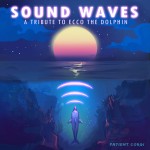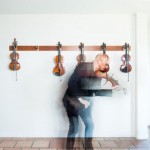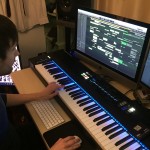[Editor’s note: We have a special audio interview with Spencer Nilsen today, courtesy of Alexander Brandon, who’s not only made a name for himself working in game audio, but also as a bit of a demoscene legend, releasing as “Siren” in the past. We’ve decided to keep the audio format by uploading it in video form to the OSVchannel, and highlights from the interview will be found after the jump. You can also find a high-quality mp3 of the recording here. We hope you enjoy this format!]
Hi all, Alex Brandon here. Around 1993 I heard some new age synth sounds coming from the next dorm room at college. I looked and saw Ecco The Dolphin being played. Since then I was hooked on the soundtrack. I found that it was composed by Magyari Andras, Brian Coburn, and Spencer Nilsen. Since then I’d wanted to interview Spencer about the experience as well as his career.
Well, at long last I’ve done it. We recorded in two seperate studios, Spencer from Ex’pression College for Digital Arts in San Francisco, and my studio at Heatwave here in Austin. At the start of the interview is a crossfade from his original Ecco track and the one found in the Genesis version. The game represents a revolutionary combination of full bore studio instrumentals and synthesizers, and the FM capabilities of the Genesis. I hope you enjoy this trip down memory lane!
Find the remaining OSVchannel links to the interview as well as highlights in transcript form after the jump!
First of all, the OSVchannel parts in list form for your convenience:
Part 1
Part 2
Part 3
Part 4
Part 5
Transcript:
Greetings, I’d like to welcome you all to an interview with Spencer Nilsen, President and Creative Director of Ex’pression College for Digital Arts. This is Alexander Brandon.
I’m conducting this interview because Spencer has created some of the most well known game soundtracks of all time, from Ecco the Dolphin to Sonic CD. Spencer’s career includes more than game music, however. He has experience with record production, as well as film and television work.
In this exclusive interview, we get a unique perspective from someone who has dabbled in all areas of music media.
AB: Spencer, great to have you with us.
SN: Well, thank you for having me, it’s an honor.
AB: I’ll start with you at age 14, you worked with San Francisco groups, working in studios, talk a little bit about that phase of your life and what got you there to working with bands like U2 and Aerosmith.
SN: Great, yeah! I started off playing piano. I’m a pianist, a vocalist, primarily a keyboardist, but I started playing when I was about five years old. My father was an architect and he had taken a job and the client had given him a pre 1900s upright piano that he put in our living room, and it became my toybox. I would play every day, stick things in the strings. I could do anything I wanted with this piano. It wasn’t the nicest piano by any stretch of the imagination but I was fascinated with all the mechanics of it and the sounds I could get out of it.
I’d say I’m 95% self taught, I did a short stint of lessons in my junior high and high school years but I was far too advanced as a player to really have a patience for the teaching. So I was playing a lot and writing my own music and very engrossed in the piano. I started to hang out at a local music store called “Don Weir’s Music City”. This is the mid 70s so the music business in the bay area was booming. We had the whole gamut of acts from Carlos Santana and Jefferson Starship. These people would shop at this store since it was the most professional of the music stores in the bay area in the time.
Since synthesizers were coming out I used to hang out in the keyboard section of the store, and the guy who ran the keyboard department was very tolerant of this kid. I was a pretty good player, making decent sounds on these things, and eventually he had me demonstrate these synthesizers for artists that would come in since I understood them more than he did. That led to some early session work.
I was thirteen at the time, so my mom was my roadie for those first couple of sessions to places like The Plant, where Rumors by Fleetwood Mac was recorded, Santana and Metallica. The first time I was in this studio it changed my life and it felt like this was home and where I wanted to spend my time. From that point forward it was all about recording and composing, even more so than live playing.
AB: So you’re steeped in synthesizers, music, and these big and popular acts but at this point your love is classical music, film and tv. You mentioned you did a PBS special, is that what led you in the direction of scoring for picture.
SN: That’s a great question, I remember noticing music in television and film early in my childhood, and it was like an epiphany. I realize that there was this marriage of these different art forms in a sense visual and aural that were much greater than the sum of the parts. Early on I was writing music and putting it against picture, and a lot of times there was no picture, but I realized the power of the combination of the two.
I realized that it wasn’t all about me and my music, it was about all the parts that went together from lighting to the sound and animation. I had a friend in college that was a dance major and asked me to score her final dance presentation for graduation, so that was my first chance to work with live dance, and even that brought a whole new slew of challenges and wonderful discoveries of how it all played together.
When I was still in San Diego before I really got heavy into film and record stuff I scored the elephant show at the San Diego Wild Animal Park. That was unbelievable, and to hear the music in the show in the stadium. Christina Pickles did the voice over, she was the star in St. Elsewhere at the time, and to see this all come together and watch the audience react was amazing.
I rented an empty office above Ingrid Croce’s restauranct, who was the widow of Jim Croce who had written a lot of songs in the 70s, so we became very close friends.
AB: You’re giving the term “small world” a whole new meaning here!
SN: All these things came together and it was in San Diego that I first met John Archer, who was one half of the duo on American Gramophone on Checkfield. He saw in me something really raw and had a lot of melodic sense that he hadn’t heard before. He went out on a limb and got me signed to American Gramophone.
John was a huge influence on my production chops since he a producer was way into the weeds of technology at the time. I remember we mastered my first record digitally in 1988. Once we had our beautiful analog two track master, we did two tracks on a Sony Betamax machine just using the digital tracks for the master and that was the first time I knew anything in digital audio with pristine sound.
AB: Getting into the American Gramophone with Chip Davis, his process that always fascinated me. I first heard his Christmas album and his rendition of “Good King Wenceslas” ages ago and was impressed by his marriage of those themes with synthesizers. I hadn’t realized that Chip Davis is someone who got into business creating demos for hi fi equipment in electronics stores, it really was a unique way of getting your music out to the public, going from demo showrooms to selling millions of albums!
SN: The guy owns Omaha, Nebraska. He stayed in his hometown, and he built a record company and studios that from an economic standpoint, you could’ve never done that in Los Angeles. He was a real entrepreneur in that he handled his own merchandise; he inventoried and warehoused his own records as well. You’re right, every Christmas album, as cheesy as it might sound, sells huge numbers. To put a drum beat behind “Deck The Halls” as simple as it might sound had never been done before, and he tops the charts every time he comes out with something new. After him it was Wyndam Hill, and it put instrumental music on the map, and I’m honored to have been a part of that.
AB: So let’s move into the video game arena. When did you get started with Sega and how?
SN: That’s a great story, I had moved back to the Bay Area. I had reconnected with a high school friend because she heard my music on the radio and told me “hey, my husband is in the music business, why not come work with him?” And at first I was dubious because you know, this guy could have played in a bar band, but her husband happened to be Walter Afanasieff who had just signed this 18 year old girl named Mariah Carey.
AB: Oh my goodness.
SN: So I come up and meet him and his walls are covered with platinum and he’s working for Boyz II Men, and writing the theme for Aladdin. I figure it’d be a good idea to head back to the Bay Area and get back into the culture. Walter and I get to know each other and work together writing some commercial stuff. During this period I get a call from out of the blue with someone from a recruiting company asking me “have you ever worked on video games?” My first response was “do video games have music?”
That’ how much I knew about it! This is 1991. I had never seen a console game, much less ever played one. Being the age I am I grew up playing arcade games and pinball but what was coming out of them I didn’t consider to be music. I don’t mean to be high and mighty, but that was just bleeps and blips!
AB: Absolutely, someone at Industrial Light and Magic wouldn’t look at Space Invaders and consider the graphics anything serious when compared to their craft, the same goes for John Williams listening to the two note score.
SN: That’s exactly right so I excused myself and I said “Hey, I’m sorry if I sound like I’m completely ignorant but maybe you could tell me what you’re looking for.” The recruiter said “Come to this company called Sega of America getting launched down on the peninsula down in Silicon Valley. Let’s sign a non disclosure and we can tell you more.” This was a jumping off point because the industry was moving into CDROM. I have to say that what I noticed was the extremes about the people I was meeting. You had rocket scientists, I mean literally there were mathematicians who had helped put the shuttle in space, and they literally were NASA engineers. At the other end of the spectrum were toy teople. The president of Sega at the time, Tom Kalinske had come from bringing Mattel out of the ashes with the reintroduction of Barbie. In between there were no entertainment people. There was no one from the music industry, and up until that point music was created by programmers with musical ability. There were also musicians with programming skills. You had to be good at the tools there to make good sounds.
When I was first introduced to the Sega Genesis it had a cartridge in the top with MIDI cables coming out of it! It basically had been hot rodded so you could control from a relatively advanced interface you could control the six voice FM operator chip. Since I had a lot of experience with the Yamaha DX7…
AB: Ah yes, all those algorithms printed on the synth itself, right?
SN: Exactly. I had a little bit of an advantage getting up to speed with this technology but I have to say 90% of what I did was full bandwidth Redbook audio. I had a lot of help from programmers in Japan converting my stuff. You had asked about Ecco. A lot of the sounds on the Genesis was an attempt by people in Japan and at Novotrade to take my full score in the CD version and make it approximated.
AB: Now I believe you wrote the theme for Sonic CD, one of the first vocal tracks in a console game, “Sonic Boom”, is that right?
SN: Yeah I did!
AB: Okay, so that was a case where you with all this work you were doing with live music and studio technology, and Sega Japan would convert your tracks to the Genesis FM synthesizer, now were you pleased with the result?
SN: I was actually blown away, especially with the Japanese programmers, I was amazed at what they were able to do with that chip. You were always note stealing. The operator that you got for a piano instrument in one section would have to convert instantly to a hi-hat in another section. Just from a production and schedule and budget standpoint, it was much more advantageous for me to make these big lush scores for the Sega CD and Saturn versions because it helped sell those systems and games.
We were doing stuff no one else was doing at the time such as Q-Sound. Especially in Ecco I was able to move whales around the players head. The deep technology used a joystick that could’ve been a flight simulator joystick.
So when you’re working parallel it was more advantageous for me to use the high tech equipment and production techniques and let the experts do the conversion, getting them as close as you could.
AB: So you’ve been doing film and record production since then, what would you say a highlight has been in more recent times?
SN: Well at Sega before anyone else as far as I know we had started signing bands and breaking them in video games. I worked with a group then called the Bygone Dogs. We featured their music in a game called Cyber Speedway for the Saturn. The game was okay but the music was great, I got a call from a battalion of Marines in the gulf because they had heard their music and it was the favorite music of the battalion. That was a very great experience.
Since then I’ve done a lot of TV commercials and finished my fourth feature film, I’ve been scoring in between 10pm and 3am for the past 6 months. It is for a film called “Moonlight Sonata” based on the Beethoven piece. It’s been making the rounds and winning awards at independent festivals, so that’s something I’m proud of.
I’ve also loved the academic environment and the discovery that happens there. When you combine that with high technology and 3D graphics and thousands of square feet of bleeding edge studios it’s just a win, so I’m having a blast here at Ex’pressions. It’s pinch yourself stuff, it’s really fun.
Tags: Alexander Brandon, Ecco the Dolphin, Features, Interviews, OSVchannel, SEGA, Sonic CD, Spencer Nilsen, Videogame








































Is the transcript being written in real time or something? Maybe a character cut-off?
Oops. Fixed.
Shouldn’t the headline read “Sonic CD” instead?
[…] Check out the full interview here […]
[…] Check out the full interview here […]
Greetings from California! I’m bored to death at work so I decided to check out your site on my iphone during lunch break.
I enjoy the info you provide here and can’t wait to take a look when I get home.
I’m surprised at how quick your blog loaded on my mobile ..
I’m not even using WIFI, just 3G .. Anyways, very good site!